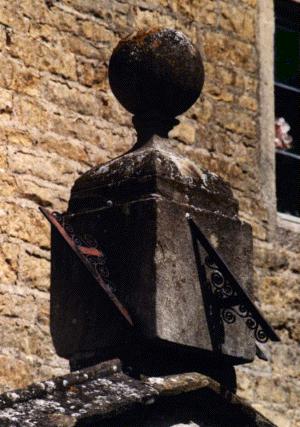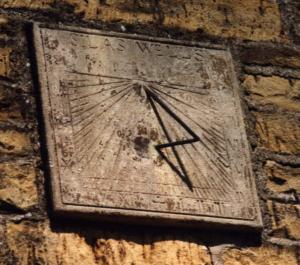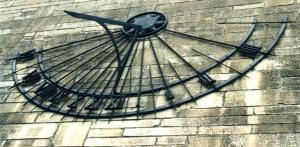by Tony Wood
This sundial trail was kindly written for your enjoyment
by Tony Wood.
It was one of the entries in the Sundial Trails Competition
2000.
|
The images on this page are the copyright © 2000 British
Sundial Society
.
first to Swindon, then to Gloucester/Cheltenham on the A417. Turn
off at the roundabout signed A429/A417 ‘Fairford’, and then an immediate
right fork takes you to ‘the Ampneys’ and Fairford.
The village of Ampney St. Peter (SP 081015),our first stop, provides
two sundials. The first (1703) on a house to the left of the road up
to the church and the church sundial itself. The church dial is unusual
in having only dots marking the hours and no numerals. It is speculated
that this indicates a very early dial based on mass dial practice. There
are also two scratch dials on the south wall.
Next stop, Fairford (SP 151012). A large ‘wool’ church, the prosperity
of local merchants providing a significant building. Its glory is its
stained glass which is well worth visiting on our journey; one good
mass dial on a south wall buttress is the only apparent dial. There
is also a memorial to ‘Tiddles’ the church cat.
Head out of Fairford on the A417 and fork left to the Eastleaches (SP
202053). Eastleach Martin and Eastleach Turville together form a Cotswold
beauty spot and have a church each. Each has a cube dial but the one
at Turville is a dreadful warning about ‘restoration’, having all three
gnomons ‘south shaped’ in stainless steel. Both churches have scratch
dials comprising a total of about eight at the last count, all facing
south.
Take the Burford road and, if you find Westwell (SP 223100)village on
the way there, the church is worth a visit, having an unusual cube dial
set into the wall instead of free standing as usual. Also we have a
Saxon dial, carved on the tympanum over the door within the porch.
Locally, there are two (or three) more Saxon dials in Gloucestershire
at Daglingworth, Saintbury (and Stowell) (SO 993050, SP 117395 and SP
1173950), the first two being carved in relief.
 Burford
offers plenty attractions as a small Cotswold town and is a good place
to stop for refreshment. If it is a lovely sunny day, a diversion to
Swinbrook (turn right halfway down Burford Hill) yields the home of
the Mitfords, the River Windrush and a church with a dial over the door. Burford
offers plenty attractions as a small Cotswold town and is a good place
to stop for refreshment. If it is a lovely sunny day, a diversion to
Swinbrook (turn right halfway down Burford Hill) yields the home of
the Mitfords, the River Windrush and a church with a dial over the door.
Returning to Burford, the A424 is temptingly direct but the minor road
through Taynton and the Barringtons offers the chance to approach Bourton
through the Rissingtons although the hills down to the Windrush valley
are quite steep.
At Bourton-on-the-Water (SP 167209) it will be busy; as a noted Cotswold
tourist attraction you will find tea-rooms and a large car park. Walking
down to the village from the car park you come out by the Dial Post
Hotel complete with magnificent cube dial (illustrated here) and its
three fancy gnomons. There is also a humble pedestal dial on the front
lawn. A few yards further on and to the right is a vertical dial above
the doorway of the Chestnut Gallery gift shop. It is in a very sad state
and must be of very soft stone.
 Bourton’s
other two dials are on the road east (to Birdland). Drink at the old
New Inn with its 1712 Silas Wells vertical dial (fig. 2) or take afternoon
tea at The Painted House opposite with an ornate 1660 pedestal dial
in the garden Bourton’s
other two dials are on the road east (to Birdland). Drink at the old
New Inn with its 1712 Silas Wells vertical dial (fig. 2) or take afternoon
tea at The Painted House opposite with an ornate 1660 pedestal dial
in the garden
. Now we turn south and head back towards Cirencester. It is probably
easiest to head towards Cheltenham/Cirencester by driving up to the
A429 and turning left, follow to Cirencester and then a left turn (SP
155204) takes you to Farmington and its church. There is a sundial and
a scratch dial with, unusually, numbers round the edge. Return to the
A429 just above the A429/A40 (SP 114155) roundabout and take time out
at Northleach if you like; (large ‘wool’ church and two or three museums).
Southwards along the A429 The Fossebridge Inn for refreshment if necessary,
and then, at Foss Cross (SP 068093) just after the next crossroads a
right turn (‘Calmsden and North Cerney’). It is a narrow road to Calmsden
(SP 045086) and, going down the village hill, on the right is a horse
trough and above it a column bearing the very weathered remains of the
village dial. The gnomon roots are just visible, otherwise it would
be almost unrecognisable as a sundial.
North Cerney (SP 018078) church with saddleback tower and mysterious
wall carvings has two sundials, a vertical one and a rare (only two
others known - Rye, Sussex and Edlingham, Northumberland) bracket dial.
The root of the gnomon is still there set in lead and pointing accurately
at north. Also two scratch dials by the small tower door.
An optional extra here is Daglingworth (SO 993050) to see the famous
Saxon dial. The easiest way is down the A417, then turn northward again
and left fork to Daglingworth. The Saxon dial is inside the porch and
there is a two faced ‘prism’ dial over the porch door.
 Retrace
your route to the A417 and Cirencester. Go round the ring road and pick
up signs for ‘Royal Ag. College’. Just before you arrive there, turn
right into Deer Park College and the Sundial Theatre (SP010014). The
theatre boasts a very good modern vertical dial (fig. 3), which came
first and gave the theatre its name. Retrace
your route to the A417 and Cirencester. Go round the ring road and pick
up signs for ‘Royal Ag. College’. Just before you arrive there, turn
right into Deer Park College and the Sundial Theatre (SP010014). The
theatre boasts a very good modern vertical dial (fig. 3), which came
first and gave the theatre its name.
Your starting point is just across the road at the Agricultural College,
thereby completing a circuit of the glorious Cotswolds.
|
 For
a full overview click
here
For
a full overview click
here  For
a full overview click
here
For
a full overview click
here